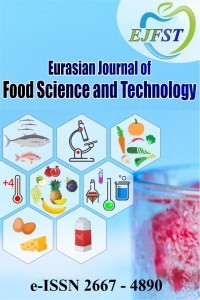Application of Gallic Acid Produced from Horse Chestnut (Aesculus hippocastanum) Shell in Table Olive Maturation
Application of Gallic Acid Produced from Horse Chestnut (Aesculus hippocastanum) Shell in Table Olive Maturation
Some important problems of a table olive processing are high salt content and microorganism occurrence, especially in fermentation. High salt content of black table olives may result an infrastructure for health problems, such as high blood pressure and related diseases and osteoporosis, and also restricts its export area. Additionally, microorganism formations lead to hygiene problems and to degradation that decrease the quality of olives. In this study, the feasibility of the polyphenol-containing vegetable extract usage in the processing of black table olives was investigated for elimination of those problems. For this purpose, as raw material known to be triterpenoid, saponin, escin, coumarin, quercetin, kaempherol and carotenoid containing horse chestnut (well-known in pharmaceutical and cosmetic industries) shells were chosen as a raw material of the extraction. Since different polyphenols components can be extracted by different solvents; water, ethanol, methanol and their binary (1:1 by volume) and triple (5:3:2 by volume of water:ethanol:methanol) combinations were performed in Soxhlet extraction in three-cycle. 16g horse chestnut shell powder/ 400ml solvent ratio were kept constant, and the amounts of polyphenols (as gallic acid equivalents) in the extracts were determined by Folin-Ciocalteu method. Experimental results showed that 55-74mg GAE/1g plant can be obtained by using pure solvents; 74-150mg GAE/1g plant in binary combinations and 12.36mg GAE/1g horse chestnut shell was obtained in triple combination. After separating the alcohol components in the extracts by distillation or completely evaporation, they were added on the brine solutions of black olives containing 0-10% brine. The table olive samples were observed and investigated for their maturation time and the amount of total microorganism formed during that stage. By comparing the results of samples with the control group consisting of 10% brine, it has been concluded that horse chestnut shell can be used in the processing of olives in the food industry.
___
- Reference 1) Dr. Öğr. Üyesi M. Cüneyt BAĞDATLI Nevşehir Hacı Bektaşı Veli Üniversitesi, cuneytbagdatli@gmail.com, İş Telefonu: 0 384 228 1000/15068
- Reference 2) Dr. Öğr. Üyesi İlknur UÇAK Niğde Ömer Halisdemir Üniversitesi, ilknurucak@ohu.edu.tr
